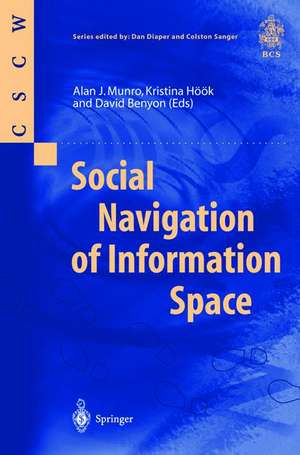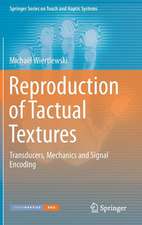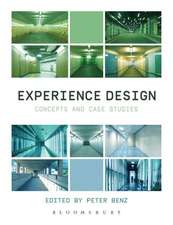Social Navigation of Information Space: Computer Supported Cooperative Work
Editat de Alan J. Munro, Kristina Höök, David Benyonen Limba Engleză Paperback – 13 aug 1999
Din seria Computer Supported Cooperative Work
- 20%
 Preț: 1044.25 lei
Preț: 1044.25 lei - 20%
 Preț: 650.59 lei
Preț: 650.59 lei - 20%
 Preț: 647.61 lei
Preț: 647.61 lei - 20%
 Preț: 638.55 lei
Preț: 638.55 lei - 20%
 Preț: 334.53 lei
Preț: 334.53 lei - 20%
 Preț: 328.79 lei
Preț: 328.79 lei - 20%
 Preț: 334.71 lei
Preț: 334.71 lei - 20%
 Preț: 330.90 lei
Preț: 330.90 lei - 20%
 Preț: 328.79 lei
Preț: 328.79 lei - 20%
 Preț: 649.28 lei
Preț: 649.28 lei - 20%
 Preț: 643.50 lei
Preț: 643.50 lei - 20%
 Preț: 329.91 lei
Preț: 329.91 lei - 15%
 Preț: 642.83 lei
Preț: 642.83 lei - 20%
 Preț: 648.11 lei
Preț: 648.11 lei - 20%
 Preț: 996.40 lei
Preț: 996.40 lei - 20%
 Preț: 647.79 lei
Preț: 647.79 lei - 20%
 Preț: 413.81 lei
Preț: 413.81 lei - 20%
 Preț: 336.02 lei
Preț: 336.02 lei - 20%
 Preț: 346.10 lei
Preț: 346.10 lei - 20%
 Preț: 330.24 lei
Preț: 330.24 lei - 20%
 Preț: 982.36 lei
Preț: 982.36 lei - 20%
 Preț: 329.11 lei
Preț: 329.11 lei - 20%
 Preț: 987.32 lei
Preț: 987.32 lei - 20%
 Preț: 641.34 lei
Preț: 641.34 lei - 20%
 Preț: 648.26 lei
Preț: 648.26 lei - 20%
 Preț: 995.89 lei
Preț: 995.89 lei - 20%
 Preț: 643.63 lei
Preț: 643.63 lei - 20%
 Preț: 988.98 lei
Preț: 988.98 lei - 20%
 Preț: 328.42 lei
Preț: 328.42 lei - 20%
 Preț: 988.81 lei
Preț: 988.81 lei - 20%
 Preț: 643.30 lei
Preț: 643.30 lei - 20%
 Preț: 987.17 lei
Preț: 987.17 lei - 20%
 Preț: 329.58 lei
Preț: 329.58 lei - 20%
 Preț: 309.58 lei
Preț: 309.58 lei - 20%
 Preț: 330.42 lei
Preț: 330.42 lei - 5%
 Preț: 365.82 lei
Preț: 365.82 lei - 20%
 Preț: 334.38 lei
Preț: 334.38 lei - 20%
 Preț: 645.79 lei
Preț: 645.79 lei - 20%
 Preț: 650.40 lei
Preț: 650.40 lei - 20%
 Preț: 333.88 lei
Preț: 333.88 lei - 20%
 Preț: 1263.81 lei
Preț: 1263.81 lei - 20%
 Preț: 830.58 lei
Preț: 830.58 lei - 20%
 Preț: 704.70 lei
Preț: 704.70 lei
Preț: 650.08 lei
Preț vechi: 812.60 lei
-20% Nou
Puncte Express: 975
Preț estimativ în valută:
124.39€ • 130.22$ • 102.93£
124.39€ • 130.22$ • 102.93£
Carte tipărită la comandă
Livrare economică 05-19 aprilie
Preluare comenzi: 021 569.72.76
Specificații
ISBN-13: 9781852330903
ISBN-10: 1852330902
Pagini: 296
Ilustrații: XIV, 278 p. 32 illus.
Dimensiuni: 155 x 235 x 16 mm
Greutate: 0.54 kg
Ediția:Softcover reprint of the original 1st ed. 1999
Editura: SPRINGER LONDON
Colecția Springer
Seria Computer Supported Cooperative Work
Locul publicării:London, United Kingdom
ISBN-10: 1852330902
Pagini: 296
Ilustrații: XIV, 278 p. 32 illus.
Dimensiuni: 155 x 235 x 16 mm
Greutate: 0.54 kg
Ediția:Softcover reprint of the original 1st ed. 1999
Editura: SPRINGER LONDON
Colecția Springer
Seria Computer Supported Cooperative Work
Locul publicării:London, United Kingdom
Public țintă
ResearchCuprins
1 Footprints in the Snow.- 1.1 Introduction.- 1.2 Mapping Social Navigation.- 1.3 Shifting Perspective.- 1.4 Social Navigation and Methodology.- 1.5 The Future of Social Navigation.- References.- 2 Where the Footprints Lead: Tracking Down Other Roles for Social Navigation.- 2.1 Introduction.- 2.2 Perspectives on Social Navigation.- 2.3 Spatial, Semantic and Social Navigation.- 2.4 New Opportunities for Social Navigation.- 2.5 Social Navigation and Collaborative Awareness.- 2.6 Social Navigation and Models of Space.- 2.7 Conclusions: New Opportunities for Social Navigation.- References.- 3 Social Connotations of Space in the Design for Virtual Communities and Social Navigation.- 3.1 Introduction.- 3.2 Social Navigation.- 3.3 Open Issues in Social Navigation.- 3.4 Social Connotations in Real and Virtual Spaces.- 3.5 Summary.- References.- 4 Informatics, Architecture and Language.- 4.1 What Underlies HCI?.- 4.2 Space Syntax.- 4.3 Information Structures Seen as Architectural Plans.- 4.4 The Path Model: An Information Access Approach Based on Activity.- 4.5 Conclusion.- References.- 5 Information that Counts: A Sociological View of Information Navigation.- 5.1 Introduction.- 5.2 The Fieldwork and the Setting.- 5.3 The Empirical Examples.- 5.4 Implications for Information Navigation on the Web.- 5.5 Conclusion.- Reference.- 6 Screen Scenery: Transposing Aesthetic Principles from Real to Electronic Environments.- 6.1 Introduction.- 6.2 Electronic Landscapes.- 6.3 The Ethnographic Study.- 6.4 Spatial Grammars.- 6.5 Presence and Orientation in Electronic Environments.- 6.6 Everyday Practices of Orientation and Perception and Spatial Grammars.- 6.7 Conclusion.- References.- 7 Navigating the Virtual Landscape: Co-ordinating the Shared Use of Space.- 7.1 Introduction.- 7.2 Shared Information Spaces.- 7.3 Methodological Approach and Research Setting.- 7.4 Observations.- 7.5 Summary and Conclusions: Co-ordinating the Shared Use of Space.- References.- 8 Spaces, Places, Landscapes and Views: Experiential Design of Shared Information Spaces.- 8.1 Introduction.- 8.2 Personal Spaces versus Public Places.- 8.3 Information Cities, Islands, Vehicles and Views.- 8.4 The Experiential Approach to HCI Design.- 8.5 Presences and Concealment.- 8.6 Conclusions.- References.- 9 The Conceptual Structure of Information Space.- 9.1 Introduction.- 9.2 Study: Users Describe Web Experience.- 9.3 Discussion.- 9.4 Conclusion.- References.- 10 A Contrast Between Information Navigation and Social Navigation in Virtual Worlds.- 10.1 Navigation.- 10.2 Home Hunting.- 10.3 Extension to Digital Representation and Social Navigation.- 10.4 Computer-Assisted Home-Hunting.- 10.5 Social Navigation: Cocktail Party Browsing.- 10.6 Computer-Assisted Remote Acquaintance.- 10.7 Comparisons: Information vs Social Navigation.- 10.8 Conclusions.- References.- 11 Understanding Representations of Space: A Comparison of Visualisation Techniques in Mainstream Cinema and Computer Interfaces.- 11.1 Introduction and Some Distinctions.- 11.2 Understanding Cinematic vs Digital Representations.- 11.3 Concluding Comments.- References.- 12 The Role of Wearables in Social Navigation.- 12.1 Introduction.- 12.2 Defining a Wearable.- 12.3 Wearables and Social Navigation.- 12.4 Augmentation.- 12.5 Time-Space Trajectories.- 12.6 Wearables in Context.- 12.7 Future Work.- 12.8 Summary — Creating Cultural Footprints.- References.- 13 Evaluating Adaptive Navigation Support.- 13.1 Introduction.- 13.2 Adaptive Navigation Systems.- 13.3 Evaluations of Adaptive Navigation Systems.- 13.4 Evaluation Criteria.- 13.5Summary.- References.- 14 Footsteps from the Garden — Arcadian Knowledge Spaces.- 14.0 Introduction: Personal and Social Navigation in Shared “Organic” Landscapes.- 14.2 Information Finding, Memory and Social Navigation.- 14.3 From Applications to Agents — Ecologies in the Interface.- 14.4 Organic Metaphors.- 14.3 The Knowledge Garden.- 14.4 (By Way of Some) Conclusions.- References.



























